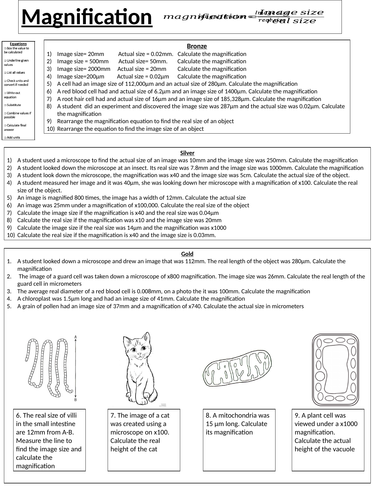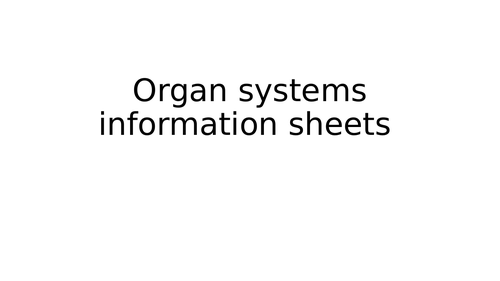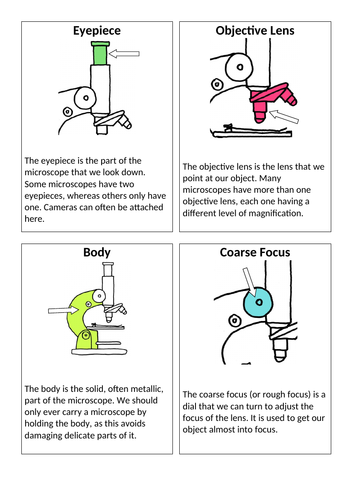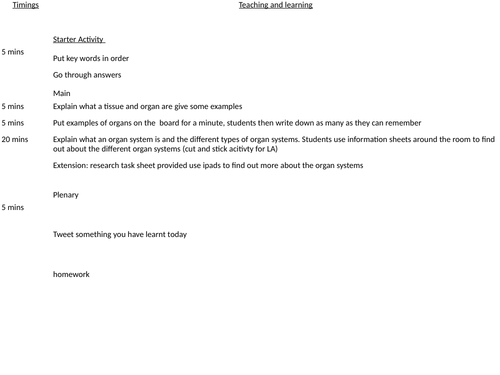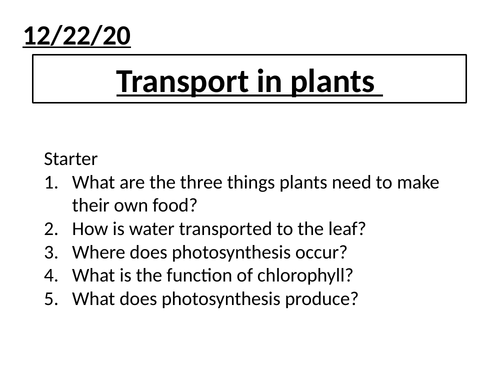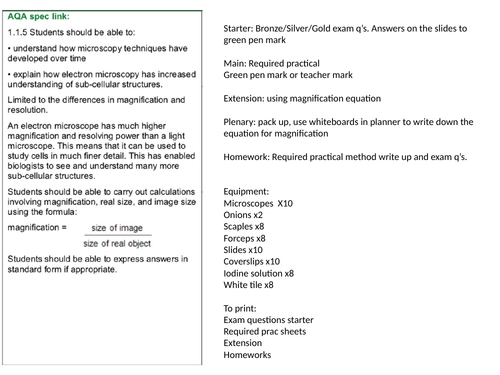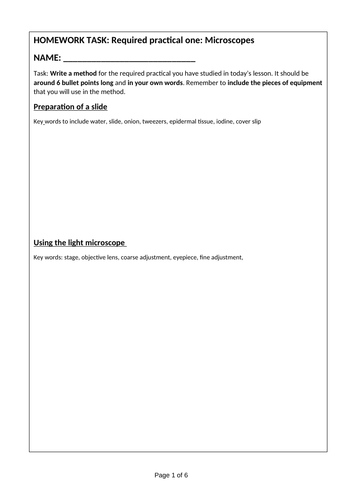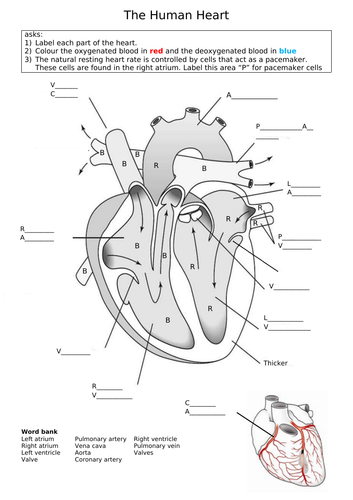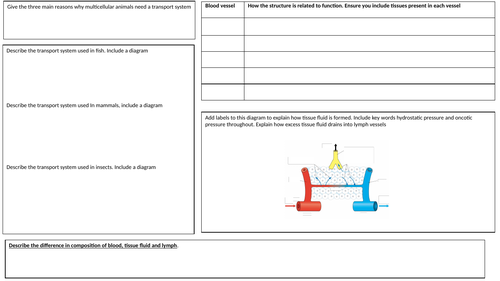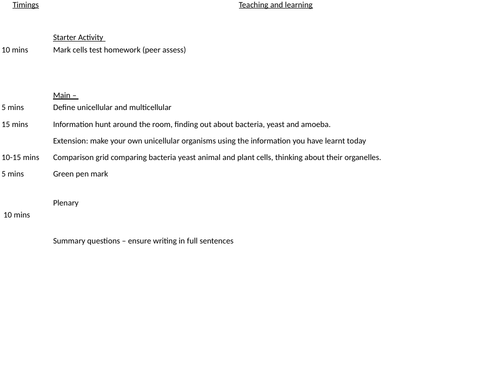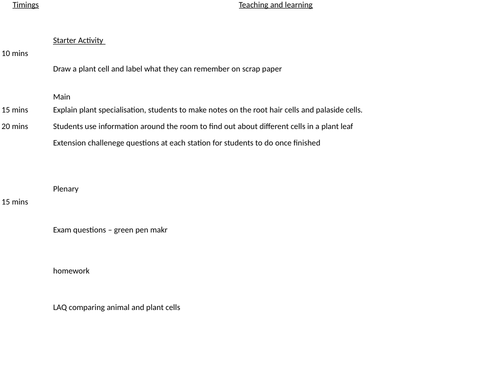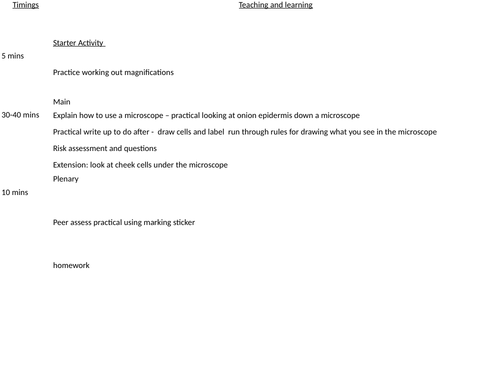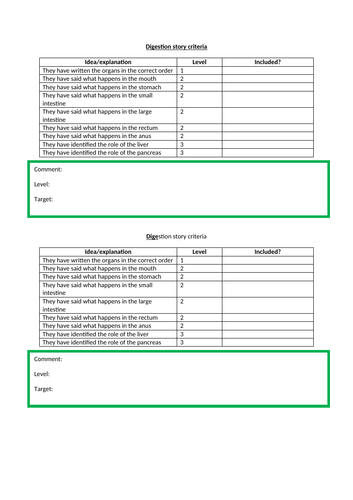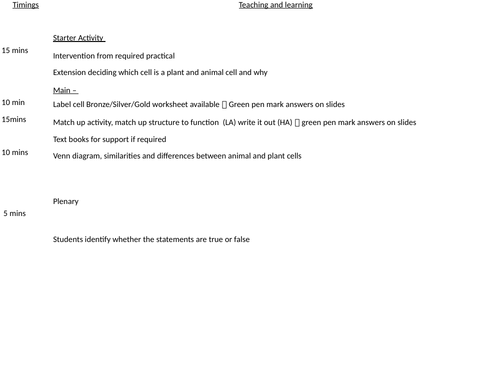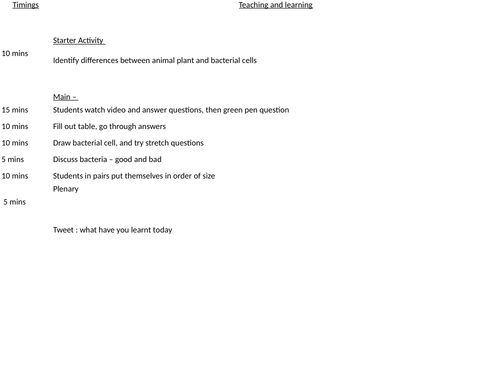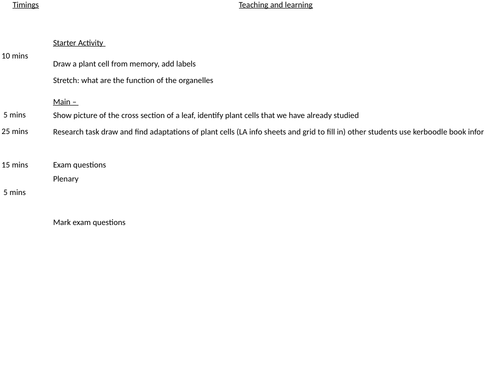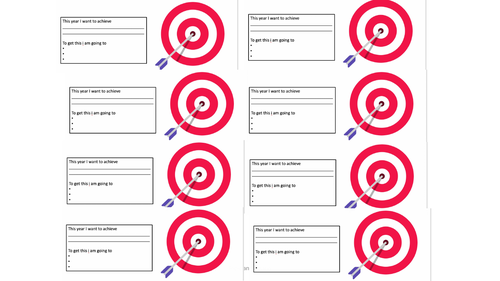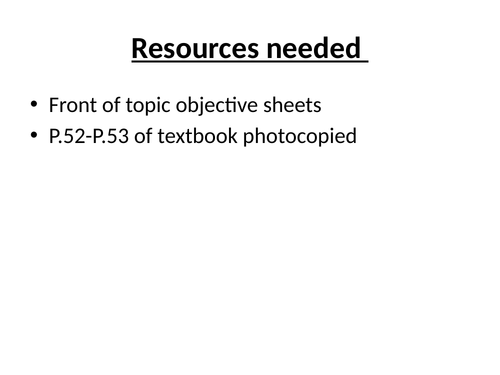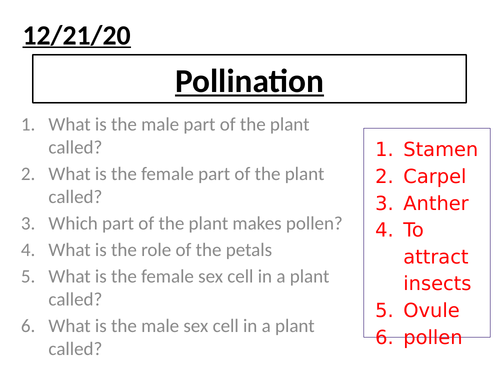
124Uploads
37k+Views
9k+Downloads
Biology

Magnification equation worksheet
Differentiated practice using the magnfication equation.
Bronze: very simple, simple put the numbers into the equation
silver: need for rearranging equation
gold: need for rearranging equation and converting between units, and measuring image size from image

Microscopes KS3
Aimed at a mixed ability year 7 class
5 mins
Differentiated questions to see what students know already about the microscope
Main
History of the microscope task – HA/LA version HA comprehension task about history, LA cut and stick to put in order
Show students parts on real microscope then cut and stick activity to label microscope parts – HA/LA version available as well as support sheets - go through answers
Extension: magnification calculations
Plenary
5 mins
Tweet something you have learnt today

Cells, tissues and organs KS3
Aimed at mixed ability year 7 class, some resources from other areas of tes
Starter: Put key words in size order and discuss
Main: discuss what cells tissues, organs are and examples
Organ systems worksheet to fill in using information around the room
LA version of cut and stick match up the organ, system and function
Extension: research extension questions about the organ systems (sheet provided)
Plenary: tweet something you have learnt today

Transport in plants KS3
Objectives:
Describe how water is transported in plants
Explain how gases enter and leave plants
explain how some plants are adapted to limit water loss
Potential practical activity of celery with food colouring, not essential for the lesson however.
Starter: Recall questions, answers on the following slide
Main - potential celery practical
discuss the role of the root hair cells, recap students prior knowledge on this
Discuss how water enters a plant, answer questions. Answers on next page
Discuss how gases get in and out of a plant
Discuss adaptations plants have in warm temperatures
Plenary - Exam questions, answers included

Microscopes required practical
Aimed at a mixed ability year 9 class
Starter: Differentiated exam questions answers on the powerpoint to mark
Main: Required practical, worksheet to complete alongside. Answers on the powerpoint to self assess after
Extension: magnification exam questions to practice , answers on the powerpoint
Plenary: Pack up, write equation from memory
Homework sheet: Exam questions on magnification and method to write for the practical

Microscopes required practical
Three differentiated resources. Cant be used as homewowrk or for required practical revision. Good to use as a retreival resource after the practical.
Each differentiated resource has a space to write the required practical method, low level sheets have key words to guide them. Each resource has different exam questions dependent on level.
All answers included.
I print 2 sheets per side, back to back. Be careful if you shrink to A5 some of the answers for the magnfication questions will change as the image size measured will be different.

Eukaryotic and Prokaryotic cells
Combining both B1.2 and B1.3 from the kerboodle topic
Starter: No goal starter, images of plant and animal cell and a microscope. students can add any information they already know. Images can be printed or a list of what they know can be wrote. To be referred to at the end of the topic, assess prior knowledge
Main:
Label plant and animal cell, differentiated version available, animated answers embedded in the powerpoint
Match structure and function of organelles
Show students bacterial cell, students draw and label their own, before filling in the comparison tick box to compare animal, plant and bacteria cells. Stretch task available
Explain key words prokaryotic and eukaryotic, then students complete the assessed questions showing understanding of differences between these cells. Self assess answer using mark scheme
Plenary
Plenary grid, can be done individually or as teams. Covers key concepts from the lesson, answers on the following slide

B4.3 The heart
Biology Aqa trilogy, B4.3
Aimed at a mixed ability class
Starter: exam question based on previous lesson on blood vessels
Main: 2 minute video to introduce heart
double circulatory task
Then differentiated task on the heart to label
Plenary : exam question on labelling the heart

Unicellular organisms KS3
Aimed at mixed ability year 7 class
Starter: how many cells make up the human body
Main: key definitions uni/multi cellular
task to move around the room and find out about different unicellular organisms
Comparison task to compare organelles in unicelllular organisms
Plenary: summary questions based on the lesson

Plant cells, tissues and organs KS3
Aimed at mixed ability year 7 class - some resources from other areas of TES
Starter: memory task, draw and label a plant cell with all they can remember
Main: draw and label root hair cell and palasaide cell, write the function and adaptations
use information around the room to fill in diagram of cells in a leaf and how they help photosynthesis
extension questions at each station
Plenary: exam questions

Microscopes practical KS3
Aimed at mixed ability year 7 class
Starter: work out magnification
Main: Complete practical looking at onion epidermis and cheek cells
practical sheet to fill in
Plenary: Peer assess their practical work

The digestive system KS3
Aimed at mixed ability year 7 class
Starter: label the digestive system, green pen mark
Main: Move around the room and find information about the key organs of the digestive system
HA/MA/LA sheets to fill in
Write a food story of food moving through the digestive system
Plenary: peer assess food story, marking sticker included

B1.2 Animal and plant cells
Aimed at a mixed ability year 9 class
Starter: identify which cell is a plant cell and which is an animal cell and explain why
Main: Label plant and animal cells differentiated worksheets (bronze silver gold)
Match up strucutre and function of organelles
venn diagram similarities and differences between plant and animal cells
Plenary: true/false questions

B1.3 Eukaryotic and prokaryotic cells
Aimed at a mixed ability year 9 class
Starter: identify differences between plant/animal/bacterial cells from images given
Main: Watch video, answer questions, green pen (answers provided on ppt)
Fill out comparison table and draw own bacterial cell
stretch questions to reach highest levels
Discussion are all bacteria bad? images to support
6 mark question to compare cells
Plenary: order of magnitude, in pairs select an image then put themselves in order

B1.5 specialisation in plant cells
Aimed at a mixed ability year 9 class
Starter: recap draw and label plant cell. Stretch, describe the role of each organelle
Main: Discuss where the palaside cells are found, discuss why they are adapted for their function being here
research task: HA/LA versions find out about root hair cells, xylem, phloem
Exam questions
Plenary: mark exam questions

B1.1 The blood
Aimed at a mixed ability year 9 class
Starter Activity
C2 retrieval practice questions – go through the answers.
Stick in objective sheets for this topic
Main –
Think pair share – what is the blood made up of? Go through answers, show students a photomicrograph of the different cells
Students then use the handout to make a grid of the function of the different parts of the blood.
Extension questions at the bottom to challenge level 4+ students
Go through answers, ensure everybody knows key function for each type of cells
Six mark question – students have ten minutes to answer questions. Then green pen mark
Watch a video of a blood donation, have a mini debate – would you give blood?
Plenary
Plenary key questions to answer

